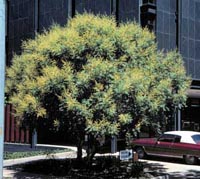Resource Library
Plant of the Week: Raintree, Golden
The University of Arkansas System Division of Agriculture does not promote, support or recommend plants featured in "Plant of the Week." Please consult your local Extension office for plants suitable for your region.
Plant of the Week
Golden Raintree
Latin: Koelreuteria paniculata

I know it’s politically incorrect to develop a fondness for foreign plants, but I
can’t help myself. The golden raintree is one of those introduced plants that has
no counterpart in the native American flora, and our gardens would be less beautiful
if it were ever to be excluded from our floral lexicon.
Golden raintree is a mid-size flowering tree that usually reaches 30 feet tall and
wide with golden yellow flowers produced from early June through late July, depending
on the flowering characteristics of the individual seedling.
The flowers of golden raintree are individually small to a half-inch across with
four petals, each bright gold and marked at the base with a cinnamon colored blotch.
The flowers are borne in large panicles up to 18 inches long and 12 inches wide with
hundreds of blooms open at any given time on the panicle.
The first flowers to open are all male flowers, but as flowering commences, female
flowers open and, upon successful pollination, the two-inch long inflated seed pods
develop. Each seed pod has three sections and resembles a Chinese lantern in general
shape. In the summer, pods are lime green in color. But as fall approaches, they turn
a shopping bag brown and hang on the tree until late winter.
Many consider the seed pods as attractive as the flowers.
Golden raintree, as a member of the soapberry family, has compound leaves with 13
to 19 leaflets per leaf. Like many members of this family it is adapted to dry difficult
sites. It is winter hardy as far north as Chicago. It is usually low branching and
develops a round head at maturity. The golden raintree made its way to the West from
Beijing about 1750 because of the efforts of a French Jesuit priest named Pierre Nicholas
d’Incarville (1706-1757). D’Incarville, after whom the hardy gloxinia (Incarvillea
sinensis) is named, was one of the early missionaries sent to China where he arrived
in 1742 to begin the Christian transformation of that land. His efforts were largely
met with indifference by the Emperor’s court until a French botanist sent him seeds
of sensitive plant, Mimosa pudica.
The movements of this touch-sensitive plant delighted the Emperor, and d’Incarville
was given seeds of some common north China plants including mimosa, tree of heaven,
oriental arborvitae and others.
The golden raintree seeds made their way to St. Petersburg Russia via a three-year
long camel caravan where botanists promptly put them on a shelf and ignored them for
20 years. Finally, in 1771, the dried plant specimens were examined and the seeds
germinated. The tree was named after a German botanist named Joseph Koelreuter who
was one of the first botanists to scientifically study plant hybridization. The tree
was introduced into the United States by Thomas Jefferson who received seeds from
Madame de Tesse, a correspondent from France.
Golden raintree is an ideal tree for areas where root room is limited and living
is hard. It is often used as a tree in small traffic islands in the middle of parking
lots and similar tough spots. It will get larger in better sites but does not seem
the least bit fussy about where it grows, so long as it has sufficient drainage. It
is somewhat difficult to transplant so it is usually better to secure container grown
plants from nurseries. It has no serious disease or insect problems.
By: Gerald Klingaman, retired
Extension Horticulturist - Ornamentals
Extension News - June 23, 2000
The University of Arkansas System Division of Agriculture does not maintain lists of retail outlets where these plants can be purchased. Please check your local nursery or other retail outlets to ask about the availability of these plants for your growing area.